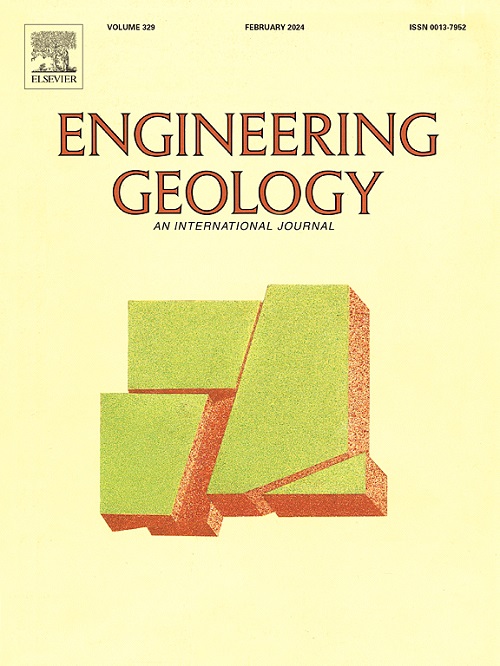Fragility and vulnerability curves of masonry buildings on slow-moving landslides: A comparative study on intensity parameters from MT-InSAR
IF 8.4
1区 工程技术
Q1 ENGINEERING, GEOLOGICAL
引用次数: 0
Abstract
Slow-moving landslides pose prolonged and severe damage to buildings. Quantifying the vulnerability of buildings is a critical step of landslide risk assessment, with landslide intensity serving as a key parameter in quantifying the vulnerability of exposure elements. However, current fragility or vulnerability modeling lacks the comparison of different intensity parameters and provides limited guidance in determining the most appropriate intensity parameter. To this aim, this paper carries out the generation and comparative study of fragility and vulnerability curves considering different intensity parameters by MT-InSAR technology. We collected 32 ENVISAT and 193 Sentinel-1A images to derive landslide intensity including maximum sliding velocity, cumulative displacement, maximum vertical velocity and differential vertical displacement through MT-InSAR technology. About 50 damaged masonry buildings were found out among near 500 residential buildings on landslides in field survey. These buildings are classified considering damages on walls and ancillary structures. Based on this, we then developed fragility and vulnerability curves using Polynomial, Exponential, Logistic, Weibull, and Sigmoid nonlinear regression functions. The results indicate that building damage responds more acutely to surface deformation in the vertical direction. In terms of fitting functions, the Sigmoid function performs optimally with cumulative displacement or maximum sliding velocity as intensity parameter, whereas the Weibull function yields the best fit with differential vertical displacement or maximum vertical velocity as intensity parameter. Vulnerability curve generated with the maximum sliding velocity or maximum vertical velocity as intensity parameter is generally applicable, while curves derived from cumulative displacement or differential vertical displacement are more suitable for the slow-moving landslides with low temporal heterogeneity in movement. In the context of slow-moving landslide risk assessment in the TGRA, we suggest to use maximum vertical velocity to analyze vulnerability of masonry buildings on slow-moving landslides.
慢动滑坡中砌体建筑易损性和易损性曲线:基于MT-InSAR强度参数的对比研究
缓慢移动的山体滑坡对建筑物造成长期和严重的破坏。建筑物易损性量化是滑坡风险评估的关键步骤,而滑坡强度是量化暴露要素易损性的关键参数。然而,目前的脆弱性或易损性建模缺乏不同强度参数的比较,对确定最合适的强度参数的指导作用有限。为此,本文利用MT-InSAR技术对考虑不同强度参数的易损性和易损性曲线进行了生成和对比研究。我们收集了32幅ENVISAT和193幅Sentinel-1 A图像,通过MT-InSAR技术获得了包括最大滑动速度、累积位移、最大垂直速度和差垂直位移在内的滑坡强度。现场调查发现,在近500栋滑坡居民楼中,砖石建筑有50余栋受损。这些建筑物根据墙壁和附属结构的损坏情况进行分类。在此基础上,我们利用多项式、指数、Logistic、威布尔和Sigmoid非线性回归函数建立了脆弱性和脆弱性曲线。结果表明,竖向地表变形对建筑物破坏的响应更为强烈。在拟合函数方面,以累积位移或最大滑动速度为强度参数时,Sigmoid函数的拟合效果最佳,而以微分垂直位移或最大垂直速度为强度参数时,Weibull函数的拟合效果最佳。以最大滑动速度或最大垂直速度为强度参数生成的易损性曲线一般适用,而以累积位移或垂直差位移生成的易损性曲线更适用于运动时间非均质性较低的慢动型滑坡。在三峡库区慢动滑坡风险评价的背景下,建议采用最大垂直速度来分析砌体建筑在慢动滑坡中的易损性。
本文章由计算机程序翻译,如有差异,请以英文原文为准。
求助全文
约1分钟内获得全文
求助全文
来源期刊

Engineering Geology
地学-地球科学综合
CiteScore
13.70
自引率
12.20%
发文量
327
审稿时长
5.6 months
期刊介绍:
Engineering Geology, an international interdisciplinary journal, serves as a bridge between earth sciences and engineering, focusing on geological and geotechnical engineering. It welcomes studies with relevance to engineering, environmental concerns, and safety, catering to engineering geologists with backgrounds in geology or civil/mining engineering. Topics include applied geomorphology, structural geology, geophysics, geochemistry, environmental geology, hydrogeology, land use planning, natural hazards, remote sensing, soil and rock mechanics, and applied geotechnical engineering. The journal provides a platform for research at the intersection of geology and engineering disciplines.
 求助内容:
求助内容: 应助结果提醒方式:
应助结果提醒方式:


